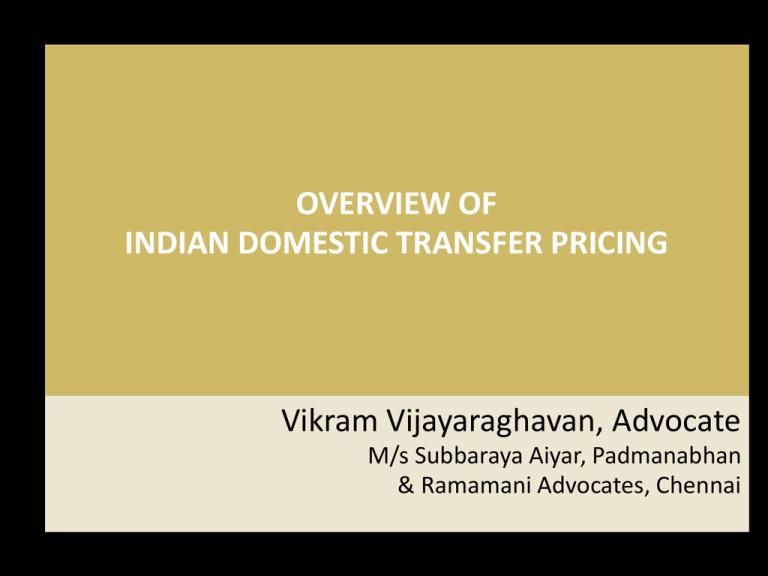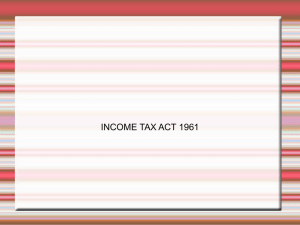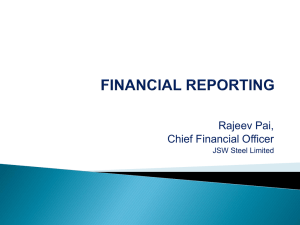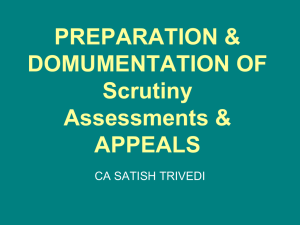Xc - Subbaraya Aiyar, Padmanabhan and Ramamani
advertisement

OVERVIEW OF INDIAN DOMESTIC TRANSFER PRICING Vikram Vijayaraghavan, Advocate M/s Subbaraya Aiyar, Padmanabhan & Ramamani Advocates, Chennai TABLE OF CONTENTS Part Topic I INTRODUCTION TO TRANSFER PRICING II EVOLUTION OF SPECIFIED DOMESTIC TRANSACTIONS (SDT) III SECTION 92BA IIIA SECTION 40A(2)(b) & SDT IIIB SECTION 80A(6) & SDT IIIC SECTION 80-IA(8), 80-IA(10), 10AA & SDT IV PRACTIAL SDT SCENARIOS…. V COMPLIANCES & PENALTIES VI DOCUMENTATION REQUIREMENTS FOR SDT VII EXECUTIVE SUMMARY PART I – An Introduction to Indian Transfer Pricing Overview of TP Rationale behind TP provisions OECD Guidelines defines “Transfer Prices” as “the prices at which an enterprise transfers physical goods and intangibles or provide services to associated enterprises” Reason for TP is that companies under-charge their services or over-price their imports to associate enterprises and thereby shift their profits abroad for various reasons Aim of TP provisions Basically, it is establishing the price charged for transactions between related entities, be it tangible property, intangible property, controlled services and financing arrangements Indian TP vs. OECD TP Guidelines FY 2001-02 - Chapter X introduced to deal with TP SIMILARITY Both base the TP regime on the Arm’s-Length Principle or ALP (defined in Sec.92F(ii)) of International transactions (Sec.92B) between Associated Enterprises (Sec.92A). DIFFERENCES • The definition of “Associate Enterprise” is quite broad under Indian TP as compared to OECD • Multiple-year data is not allowed in Indian TP except under certain circumstances • Arithmetic mean of comparables is used in Indian TP and not inter-quartile ranges • Indian TP has stringent documentation guidelines • Indian TP lacks guidelines for intra-group set-offs Indian TP provisions TP in Practice Practical TP assessment • (ALP) means a price applied or proposed to be applied in a transaction between nonAssociated Enterprises in uncontrolled conditions •The most appropriate method shall be applied for determination of the ALP out of CUP, RPM, Cost+, Profit-Split, TNMM methods (and the sixth method now prescribed by CBDT) •Where more than one price is determined by the most appropriate method, the ALP will be the arithmetic mean of such prices. •Where arm’s length price is within 5% range of the transaction price, no adjustment is warranted (i.e., 5% band and not standard deduction). For A.Y.2013-14 onwards, tolerance range would be notified by the central government subject to maximum 3% FINANCE ACT 2012 Increased penalty Provisions for TP Scope of TP expanded to include SPECIFIED DOMESTIC TRANSACTIONS (SDT) Scope of ‘International Transactions’ retrospectively enlarged to include Guarantees, debts etc. Power of appeal by Dept. against DRP Order APA introduced Increase in scope of powers of TPO PART II. EVOLUTION OF SDT (SPECIFIED DOMESTIC TRANSACTIONS) CIT Vs Glaxo Smithkline Asia (P) Ltd Reasons for Recommendation • In the case of CIT Vs Glaxosmithkline Asia (P) Ltd. [(2010) 236 CTR (SC) 113], the Hon’ble Supreme Court made recommendations to extend the TP regulations to the domestic transactions covered under Section 40 A(2) and 80-IA(10). “In the case of domestic transactions, the under-invoicing of sales and overinvoicing of expenses ordinarily will be revenue neutral in nature, except in two circumstances having tax arbitrage— [i] If one of the related Companies is loss making and the other is profit making and profit is shifted to the loss making concern; and [ii] If there are different rates for two related units [on account of different status, area based incentives, nature of activity, etc.] and if profit is diverted towards the unit on the lower side of tax arbitrage. For example, sale of goods or services from non-SEZ area [taxable division] to SEZ unit [nontaxable unit] at a price below the market price so that taxable division will have less profit taxable and non-taxable division will have a higher profit exemption” CIT Vs Glaxo Smithkline Asia (P) Ltd Irony? “In order to reduce litigation, we are of the view that certain provisions of the Act, like Section 40A(2) and Section 80IA(10), need to be amended empowering the Assessing Officer to make adjustments to the income declared by the assessee having regard to the fair market value of the transactions between the related parties. The Assessing Officer may thereafter apply any of the generally accepted methods of determination of arm's length price, including the methods provided under Transfer Pricing Regulations…………Normally, this Court does not make recommendations or suggestions. However, as stated above, in order to reduce litigation occurring in complicated matters……” PART III. Section 92BA Section 92BA Meaning of specified domestic transaction 92BA. For the purposes of this section and sections 92, 92C, 92D and 92E, "specified domestic transaction" in case of an assessee means any of the following transactions, not being an international transaction, namely:— (i) any expenditure in respect of which payment has been made or is to be made to a person referred to in clause (b) of sub-section (2) of section 40A; (ii) any transaction referred to in section 80A; (iii) any transfer of goods or services referred to in sub-section (8) of section 80-IA; (iv) any business transacted between the assessee and other person as referred to in sub-section (10) of section 80-IA; (v) any transaction, referred to in any other section under Chapter VI-A or section 10AA, to which provisions of sub-section (8) or sub-section (10) of section 80-IA are applicable; or (vi) any other transaction as may be prescribed and where the aggregate of such transactions exceeds a sum of five crore rupees PART IIIA. Section 40A(2)(b) & SDT Section 40A(2)(a) Proviso to S.40A(2)(a) 40A(2)(a) Where the assessee incurs any expenditure in respect of which payment has been or is to be made to any person referred to in clause (b) of this sub-section, and the Assessing Officer is of opinion that such expenditure is excessive or unreasonable having regard to the fair market value of the goods, services or facilities for which the payment is made or the legitimate needs of the business or profession of the assessee or the benefit derived by or accruing to him therefrom, so much of the expenditure as is so considered by him to be excessive or unreasonable shall not be allowed as a deduction : Provided that no disallowance, on account of any expenditure being excessive or unreasonable having regard to the fair market value, shall be made in respect of a specified domestic transaction referred to in section 92BA, if such transaction is at arm's length price as defined in clause (ii) of section 92F Section 40A(2)(a) – Substantial interest Definition of substantial interest Explanation.—For the purposes of this sub-section, a person shall be deemed to have a substantial interest in a business or profession, if,— (a) in a case where the business or profession is carried on by a company, such person is, at any time during the previous year, the beneficial owner of shares (not being shares entitled to a fixed rate of dividend whether with or without a right to participate in profits) carrying not less than twenty per cent of the voting power; and (b) in any other case, such person is, at any time during the previous year, beneficially entitled to not less than twenty per cent of the profits of such business or profession. irector or any other relative of the Director who has substantial interest in the business of the assessee, he assessee or any relative of the assessee having •Explanation substantial clause interest of Section in the 40A(2)(b). business of any other assessee. he term ‘Substantial interest’ denotes more than 20% of shareholding as per the Explanation clause of Section 40A(2)(b). Case 1 - Section 40A(2)(b)(ii) Director or any relative of Director Relative in relation to individual means husband, wife, brother or sister or any lineal ascendant or descendant of that individual Relative Mr. A Mr. B Director Mr. C Director XYZ Ltd. (assessee) denotes Specified Domestic Transaction (SDT) irector or any other relative of the Director who has substantial interest in the business of the assessee, he assessee or any relative of the assessee having •Explanation substantial clause interest of Section in the 40A(2)(b). business of any other assessee. he term ‘Substantial interest’ denotes more than 20% of shareholding as per the Explanation clause of Section 40A(2)(b). Case 2 – Section 40A(2)(b)(iii) Individuals having substantial interest in business of assessee or any relative of such individual Relative Relative Mr. B Director Mr. A Substantial interest > 20% XYZ Ltd. (assessee) denotes SDT Mr. C irector or any other relative of the Director who has substantial interest in the business of the assessee, he assessee or any relative of the assessee having •Explanation substantial clause interest of Section in the 40A(2)(b). business of any other assessee. he term ‘Substantial interest’ denotes more than 20% of shareholding as per the Explanation clause of Section 40A(2)(b). Case 3.1 - Section 40A(2)(b)(iv) To a company having substantial interest in the business of XYZ Ltd. or Director of such company or any relative of Director Director XYZ Ltd. Relative Mr.A Substantial interest > 20% ABC Ltd. – assessee denotes SDT Mr. B irector or any other relative of the Director who has substantial interest in the business of the assessee, he assessee or any relative of the assessee having •Explanation substantial clause interest of Section in the 40A(2)(b). business of any other assessee. he term ‘Substantial interest’ denotes more than 20% of shareholding as per the Explanation clause of Section 40A(2)(b). Case 3.2 - Section 40A(2)(b)(iv) Any other company carrying on business in which the first mentioned company has substantial interest Substantial interest > 20% XYZ Ltd. Substantial interest > 20% ABC Ltd. – assessee denotes SDT DEF Ltd. irector or any other relative of the Director who has substantial interest in the business of the assessee, he assessee or any relative of the assessee having •Explanation substantial clause interest of Section in the 40A(2)(b). business of any other assessee. he term ‘Substantial interest’ denotes more than 20% of shareholding as per the Explanation clause of Section 40A(2)(b). Case 4 - Section 40A(2)(b)(v) To a company of which a Director has substantial interest in the business of XYZ Ltd. or any other Director of such company or relative of Director Director Mr. A Director XYZ Ltd. Mr. C Relative Substantial interest > 20% ABC Ltd. Assessee denotes SDT Mr. D irector or any other relative of the Director who has substantial interest in the business of the assessee, he assessee or any relative of the assessee having •Explanation substantial clause interest of Section in the 40A(2)(b). business of any other assessee. he term ‘Substantial interest’ denotes more than 20% of shareholding as per the Explanation clause of Section 40A(2)(b). Case 5.1 - Section 40A(2)(b)(vi) To a company in which ABC Ltd. has substantial interest in the business of the company ABC Ltd. Substantial interest > 20% XYZ Ltd. denotes SDT irector or any other relative of the Director who has substantial interest in the business of the assessee, he assessee or any relative of the assessee having •Explanation substantial clause interest of Section in the 40A(2)(b). business of any other assessee. he term ‘Substantial interest’ denotes more than 20% of shareholding as per the Explanation clause of Section 40A(2)(b). Case 5.2 - Section 40A(2)(b)(vi) Any director or relative of a director of XYZ Ltd. having substantial interest in that person Relative Mr. A Substantial interest > 20% Mr. B Director XYZ Ltd. Substantial interest > 20% DEF Ltd. ABC Ltd. assessee denotes SDT Issues with S.40A(2) • Diligence in identification of Specified Domestic Transactions • Benchmarking of MD/Director’s remuneration • Contemporaneous documentation tedious to maintain • Identification of comparables and providing suitable adjustments maybe a herculean task PART IIIB. Section 80A(6) & SDT Section 80A(6) Section 80A(6) “(6) Notwithstanding anything to the contrary contained in section 10A or section 10AA or section 10B or section 10BA or in any provisions of this Chapter under the heading "C—Deductions in respect of certain incomes", where any goods or services held for the purposes of the undertaking or unit or enterprise or eligible business are transferred to any other business carried on by the assessee or where any goods or services held for the purposes of any other business carried on by the assessee are transferred to the undertaking or unit or enterprise or eligible business and, the consideration, if any, for such transfer as recorded in the accounts of the undertaking or unit or enterprise or eligible business does not correspond to the market value of such goods or services as on the date of the transfer, then, for the purposes of any deduction under this Chapter, the profits and gains of such undertaking or unit or enterprise or eligible business shall be computed as if the transfer, in either case, had been made at the market value of such goods or services as on that date” Section 80A(6) contd… Explanation to Section 80A(6) “Explanation.—For the purposes of this sub-section, the expression "market value",— (i) in relation to any goods or services sold or supplied, means the price that such goods or services would fetch if these were sold by the undertaking or unit or enterprise or eligible business in the open market, subject to statutory or regulatory restrictions, if any; (ii) in relation to any goods or services acquired, means the price that such goods or services would cost if these were acquired by the undertaking or unit or enterprise or eligible business from the open market, subject to statutory or regulatory restrictions, if any; (iii) in relation to any goods or services sold, supplied or acquired means the arm's length price as defined in clause (ii) of section 92F of such goods or services, if it is a specified domestic transaction referred to in section 92BA.” PART IIIC. Section 80-IA(8), 80-IA(10), 10AA & SDT Section 80-IA(8) Any transfer of goods or services referred under Section 80-IA(8) “(8) Where any goods or services held for the purposes of the eligible business are transferred to any other business carried on by the assessee, or where any goods or services held for the purposes of any other business carried on by the assessee are transferred to the eligible business and, in either case, the consideration, if any, for such transfer as recorded in the accounts of the eligible business does not correspond to the market value of such goods or services as on the date of the transfer, then, for the purposes of the deduction under this section, the profits and gains of such eligible business shall be computed as if the transfer, in either case, had been made at the market value of such goods or services as on that date : … Explanation.—For the purposes of this sub-section, "market value", in relation to any goods or services, means— (i) the price that such goods or services would ordinarily fetch in the open market; OR (ii) the arm's length price as defined in clause (ii) of section 92F, where the transfer of such goods or services is a specified domestic transaction referred to in section 92BA. 80-IA(8) example Extraordinary profits ABC Ltd. Unit A Telecom Business Transfer at Rs.150 Market value of Rs.100 ALP would be taken as Rs.100 Goods & Services Unit B Manufacturing Business Section 80-IA(10) Any transfer of goods or services referred under Section 80-IA(8) (10) Where it appears to the Assessing Officer that, owing to the close connection between the assessee carrying on the eligible business to which this section applies and any other person, or for any other reason, the course of business between them is so arranged that the business transacted between them produces to the assessee more than the ordinary profits which might be expected to arise in such eligible business, the Assessing Officer shall, in computing the profits and gains of such eligible business for the purposes of the deduction under this section, take the amount of profits as may be reasonably deemed to have been derived therefrom: Provided that in case the aforesaid arrangement involves a specified domestic transaction referred to in section 92BA, the amount of profits from such transaction shall be determined having regard to arm's length price as defined in clause (ii) of section 92F. 80-IA(10) example Extraordinary profits ABC’s Ltd. Infrastructure unit Close connection Goods & Services Operating Margin 35% (Extraordinary profits) Industry Average 10% ALP will be taken as10% XYZ Ltd. Issues with SDT & 80A, 80-IA and 10AA Issues and Challenges •Any transaction referred in Chapter VI-A or Section 10AA to which 80-IA (8) or 80IA(10) are applicable •Now, transfers between inter-units and with other business are all covered. A general broad sweep of common transactions by companies is now under SDT •The term ‘close connection’ NOT DEFINED. It could be interpreted to mean companies which participate directly or indirectly or through one or more intermediaries in the management or control or capital of the company. It also includes companies which are not related but with which it has financial or dealings or any other arrangements which may or may not be for tax arbitrage. •Whether Capital account transactions are covered? •Double-disallowances are possible (example later) FAIR MARKET VALUE vs. ALP Particulars Fair Market Value Arm’s length Price Basis of Distinction The term Fair Market Value is not By introducing ALP, there defined under the Act. will be a shift from discretionary undefined situation to a situation which would showcase a greater discipline. Definition The price which the goods or services would fetch in the open market. A price which is applied in a transaction in uncontrolled conditions. Computation Mechanism No specific mechanism provided in law. Appropriate method out of the five methods which have been prescribed. FAIR MARKET VALUE vs. ALP Particulars Fair Market Value Arm’s Length Price Transaction Value Any market price point can be treated as FMV. Arithmetic mean of comparable prices treated as ALP. Sample Size One comparable is sufficient to determine FMV. Require bigger sample size for determining ALP Deviation No deviation permitted from FMV. Plus or minus 3% deviation is allowed PART IV. PRACTIAL SDT SCENARIOS…. (Points to Ponder!) irector or any other relative of the Director who has substantial interest in the business of the assessee, he assessee or any relative of the assessee having •Explanation substantial clause interest of Section in the 40A(2)(b). business of any other assessee. he term ‘Substantial interest’ denotes more than 20% of shareholding as per the Explanation clause of Section 40A(2)(b). Example 1: Supply of parts to group companies Local Manufacturer of Piston Rings Group Company Supply to third-party of piston rings Leading Automobile company (*) OE as well as After-market sales denotes SDT Local Manufacturer of Pistons irector or any other relative of the Director who has substantial interest in the business of the assessee, he assessee or any relative of the assessee having •Explanation substantial clause interest of Section in the 40A(2)(b). business of any other assessee. he term ‘Substantial interest’ denotes more than 20% of shareholding as per the Explanation clause of Section 40A(2)(b). Example 2: Payment towards Logo/Brand charges Holding company having ownership of brand/logo/trademarks Logo charges @ 1.25% of sales Group company (Healthcare) denotes SDT Group company (Insurance) Group company (Home appl.) - Benchmarking issues –how to value brand? - Over long period, holding company might be held to derive some benefit from group companies… irector or any other relative of the Director who has substantial interest in the business of the assessee, he assessee or any relative of the assessee having •Explanation substantial clause interest of Section in the 40A(2)(b). business of any other assessee. he term ‘Substantial interest’ denotes more than 20% of shareholding as per the Explanation clause of Section 40A(2)(b). Example 3: Double disallowance under SDT Double disallowance possible when dealing with 10AA/80-IA units 10AA unit of group ALP Rs.100 Sale of goods Rs.150 - Sold at less than ALP - More than ordinary profit made - Disallowance of Rs.50/- denotes SDT Non-eligible unit of group - Expenditure (payment) less than ALP - Disallowance of Rs.50/- irector or any other relative of the Director who has substantial interest in the business of the assessee, he assessee or any relative of the assessee having •Explanation substantial clause interest of Section in the 40A(2)(b). business of any other assessee. he term ‘Substantial interest’ denotes more than 20% of shareholding as per the Explanation clause of Section 40A(2)(b). Example 4: HQ Allocation & Inter-unit HEAD OFFICE / CORPORATE OFFICE Unit – 1 SEZ Rs.350/- per hour Third-party insurance business Rs.150/per hour UNIT - 2 INSURANCE UNIT – 3 TELECOM Rs.250/per hour - Whether head office expenses required to be allocated with markup under Domestic TP? - Will allocation be challenged? - Whether ITES provision by Unit-1 to all other units will come under Domestic TP? irector or any other relative of the Director who has substantial interest in the business of the assessee, he assessee or any relative of the assessee having •Explanation substantial clause interest of Section in the 40A(2)(b). business of any other assessee. he term ‘Substantial interest’ denotes more than 20% of shareholding as per the Explanation clause of Section 40A(2)(b). Example 5: Interest free loan Interest free loan given to eligible unit – extraordinary profit? Interest Free Loan Eligible unit of ABC Ltd. ABC Ltd. Loan given @ 17% Non-Eligible unit of ABC Ltd. - Also extraordinary profit of eligible unit, disallowance possible - As per AO, ALP loan at market @ 12% - subsidiary expenditure on interest is excess Part V : Compliance & Penalties Applicability Of TP provisions to SDT Section Provisions Applicability of Specified Domestic Transaction 92 Computation of Income having regard to Arm’s Length price Yes 92A Meaning Of Associated Enterprise No 92B Meaning Of International Transaction No 92BA Meaning Of Specified Domestic Transaction Yes 92C Methods Of Computation of Arm’s Length Price Yes 92CA Reference to transfer pricing Officer Yes 92CB Safe Harbor Rules Yes 92CC Advance Pricing Agreement No 92CD Effect Of Advance Pricing Agreement No 92D Maintance Of Information and Documents Yes 92E Accountant’s Report Yes 144C Dispute Resolution Panel Yes(?) COMPLIANCES AND PENALTIES Particulars Compliance to be followed Penalties Filing of the Audit Report in Form 3CEB Mandatory to file Form 3CEB before the due date of filing return of income if the value of SDT exceeds INR 5 crs or even if there is international transaction with Associated Enterprises of even a single Rupee Rs 1,00,000 (Sec 271BA) Reporting of each SDT and international transaction entered into with related party in Form 3CEB Mandatory to report every transaction in form 3CEB 2% Of the value of each transaction (Sec 271AA) Maintance of transfer pricing Documentation Mandatory to maintain documentation where transaction subject to transfer pricing exceed 1Cr.in a financial year for international transaction & INR 5 Cr for SDT 2% Of the value of each transaction (Sec 271AA) Maintance and furnishing Mandatory to maintain and furnish correct 2% Of the value of each Concealment of particulars of income and furnishing inaccurate particulars thereof Mandatory to furnish correct particulars of transaction before the Revenue authorities Penalty ranging from 100% to 300% of the amount of tax sought to be evaded if adjustment is made by the Revenue authorities (Expl.7 to Sec.271(1) (c) Failure to Furnish information or documents as required under section 92D(3) Mandatory to furnish information or documentation required by the revenue authorities within timelines as per section 92(D)(3) Penalty @ 2% of the value of the transaction for each such failure(Sec 271 G) Overview of Penalties Penalty provisions of TP made applicable to SDT 2% of Transaction Value for: a) Non-maintenance of documents b) Non-submission of documents In case of adjustment 100% to 300% of additional tax New penalty provisions for TP & SDT w.e.f. 01.04.2013 2% of Transaction Value for: Non-reporting of transaction b) For incorrect maintenance/submission of documents CURRENT & ADDITIONAL COMPLIANCE REQUIREMENTS FOR SDT CURRENT COMPLIANCES ADDITIONAL COMPLIANCES •Section 40A – Transactions to be reported in Tax Audit Report in Form 3CD •Section 10AA – CA Certificate in Form 56F needs to be filed •Section 80IA – Declaration of profit to be made by CA in Form 10CCB • Maintain contemporaneous documentation as prescribed in Rule 10D and prove that transactions are at ALP by selecting MAM • Filing audit report in Form 3CEB/any other Form that may be prescribed Part VI :Documentation required for SDT Section 92D w.r.t SDT Maintenance Of Information and Documents (Sec 92D) As per section 92D, every person who has entered into Specified Domestic Transaction shall keep and maintain such information and documents in respect thereof, as prescribed in RULE 10D. Organizational Structure Nature of business Profile of companies with which assessee has specified domestic transaction Controlled transactions Background documents Comparability, functional and risk analysis Industry and market conditions forecasts/ budget, financial estimates Uncontrolled transactions and comparability analysis Selection of transfer pricing method Application of the transfer pricing method Assumptions, strategies, policies Supporting information Documentation Need and Importance •Onus on the Assessee to prove the genuineness of the transaction. •Information is gathered from databases such as Capitaline and Prowess and other public sources. •Assessee has to find proper comparables to determine acceptable Arm’s Length Price. •Assesse has to substantiate the Value ascertained for the transaction. •Non-substantiation leads to rejection by TPO SDT – Typical Workflow Typical workflow of SDT • • • • • Identification of Specified Domestic Transactions Function, Assets & Risk Analysis Comparable transactions identification Choose Most Appropriate Method Adjustments for differences between comparables and assessee transactions • Computation of ALP • Documentation, Return Filing and Form 3CEB filing • Assessment proceedings Documentation Synopsis Entity Related Price Related • Industry Profile • Group Profile • Company Profile • Related Party Profile • Terms between Parties • FAR Analysis • Comparability Analysis Transaction Related • • • • • • Agreements Invoices Raised Accounts Annual Reports Business plans Comm. affecting price Types of Transactions and the documents required ……. Documentation….. Certain Transactions and their Required Documents Purchase/ sale of Raw Materials Reimburse ment of Expenses • • • • Purchase/ Sale order Invoices Product details Pricing strategy & negotiation • Terms of payment • Sales to 3rd parties • Quotes from competitors • Nature of expenses with break-up • Employee details • Actual invoices • Reason for expenses Remuneration to Director Interest on Loan • • • • Qualification Experience Profile Minutes of meetings • HR data of other firms • Loan agreement • Interest Rate, basis of determination • Rate card for period of loan • Reason for higher or lower interest rate Rent Paid • Rental agreement • Rent receipts • Fair market value of the property (municipal valuation) • Reliable sources of rent in surrounding area Corporate Cost Sharing • • • • • Nature of expenses Proof of services Cost benefit analysis Basis of allocation Auditor’s certificate Executive Summary What is in store ahead? • SDT regime is onerous – more work for everyone involved • S.40A(2)(b) requires due diligence for coverage of all possible cases • All special deductions (Chapter VI, S.10AA etc) under attack now • Thousands of practical everyday transactions happening in Indian business now will be under scrutiny • Benchmarking, documentation, comparability issues are points of concern • Leverage for the Department to go after a huge swath of transactions. SDT is a likely a step back in terms of tax certainty and business-friendly environment Thank you! Contact details vvikram@saprlaw.com yourvakil@gmail.com http://www.saprlaw.com Free tax Blog and newsletter- number of articles, presentations and analysis Acknowledgments: Ms.B.Mala, Mr.V.P.Thangadurai, Ms.R.Bhavya, Mr.R.Dhiraj, Mr.Prashanth Jain SAPR Advocates







